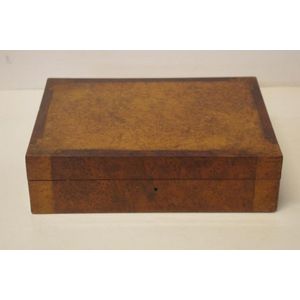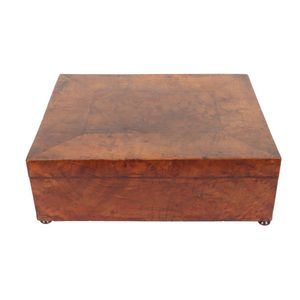Early 19th Century Musk Writing Box
You must be a subscriber, and be logged in to view price and dealer details.
Subscribe Now to view actual auction price for this item
When you subscribe, you have the option of setting the currency in which to display prices to $Au, $US, $NZ or Stg.
- Huon Pine - Named after the Frenchman who discovered the Huon River in Tasmania, it is an extremely slow growing and long living tree. Huon pine is native to Tasmania, and it can grow to an age of 3,000 years or more. The wood contains oil that retards the growth of fungi, hence its early popularity in ship-building in convict-era Tasmania. The timber is a warm yellow colour, finely grained, and was popular for household furniture in the Victorian era. Interestingly, much Huon pine furniture was made in South Australia. Huon pine is a protected species and only limited quantities are available nowadays, for craftsmen to manufacture small items such as platters, sculptures and other decorative objects.
- Burr - Burr (or in the USA, burl) is the timber from the knotted roots or deformed branch of the tree, which when cut, displays the small circular knots in various gradations of colour. It is always cut into a decorative veneer, most commonly seen as burr walnut on 19th century furniture.
- Musk Wood - The musk is native to Tasmania, and is found in the rainforests and wetter regions especially along river banks. It grows to a height of between five and fifteen metres, it has a musk scent. A rare timber and therefore mainly used as a veneer in the 19th-century, it is light brown in colour and furniture constructed from it is very expensive.
- Maple - Maple, native to North America, is a dense heavy timber from light to yellow-brown in colour. It has very little distincive graining unless it is one of the variants such as birds-eye maple or burr maple, so was not used extensively for furniture in 18th and 19th century, where cabinetmakers and designers preferred timbers with more distinctive features such as mahogany, walnut, rosewood and oak.
Birds-eye maple has a seres of small spots linked by undulating lines in the grain, is highly sough and is used as a decorative veneer. Burr maple has larger and irregular grain swirls than birds-eye maple.
This item has been included into following indexes:
- boxes, material or decoration
- boxes, writing
Visually similar items

A campaign style walnut writing slope, 19th century, a brass trimmed slope with shield cartouche and matching escutcheon opening to a tooled black leather slope and fitted compartments for pens and inks, height 13 cm, width 40 cm, depth 23 cm

Rustic timber trunk with metal handles & lock, 108 cm wide

Vintage poker chip box, with burl grain veneer and fitted interior, 29 cm wide, 20 cm deep, 8 cm high approx

An antique American oak trunk, original lining paper depicting American scenes, condition: original lock and hinges intact, restored condition, 35 x 83 x 54.5 cm
